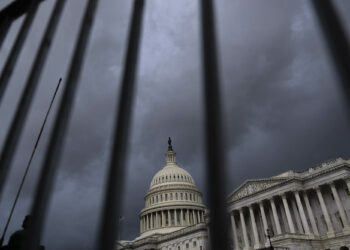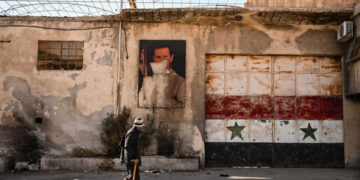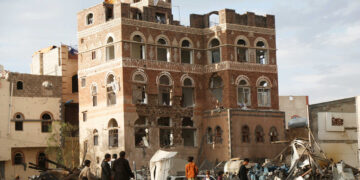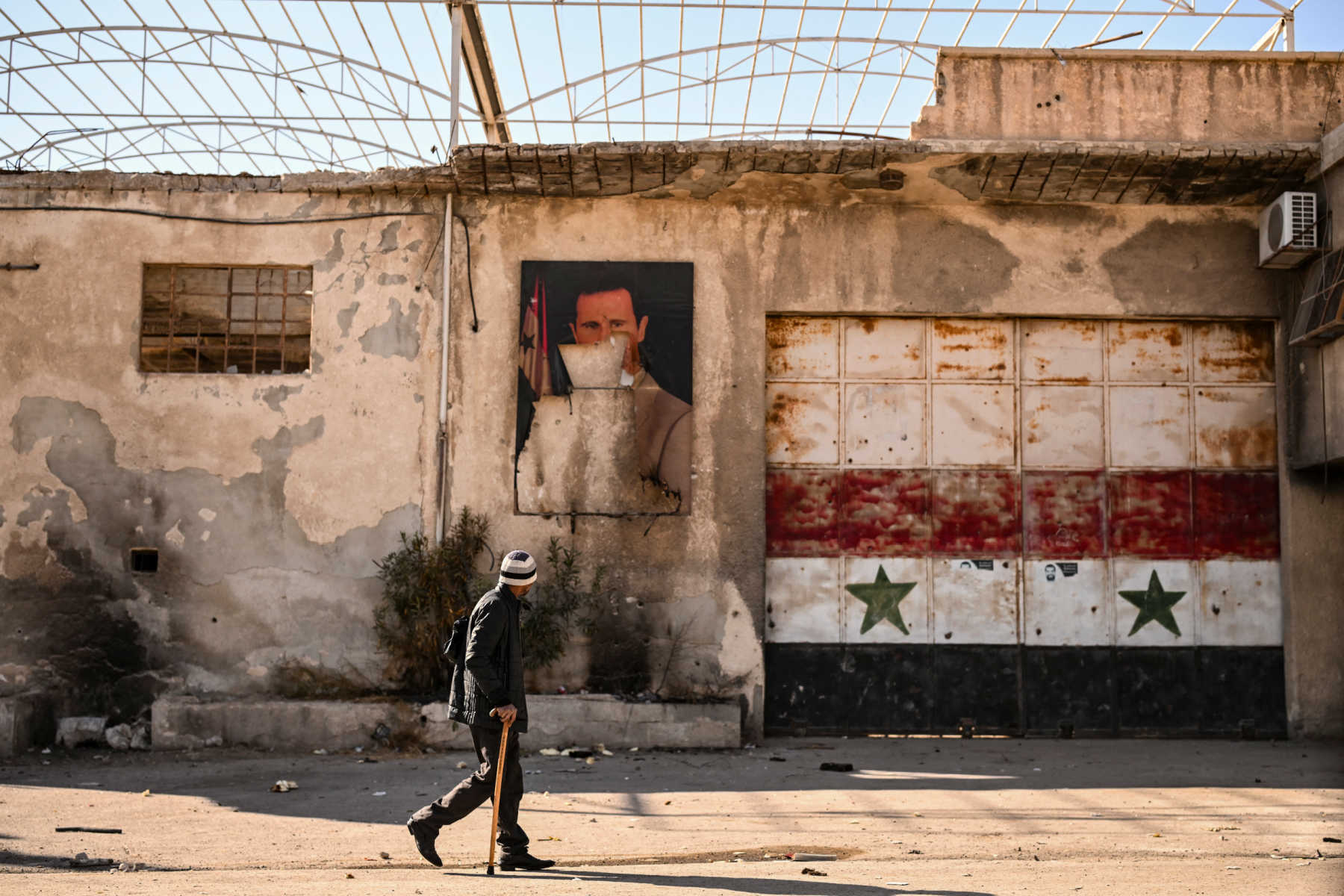*Ahmad Algohbary is a freelance Yemeni journalist who has reported on the Yemen war for international media since war broke out in 2015. His work has appeared in The Guardian and Al Jazeera English, among other outlets. As Co-Director of Photography, Aloghbary filmed the 2018 documentary “Yemen Skies of Terror,” which was nominated for Emmy and Sheffield Awards, and won an online journalism award. Algohbary has also launched a public funding campaign via his Twitter account to provide support for child victims of the war. He tweets at @AhmadAlgohbary.
عربي
Time was running out for Muhammad Zabara when medics attended to his sick infant daughter, Abrar, who was hospitalized in Sanaa. She was suffering from months of malnutrition, acute nephritis and complicating heart problems. The baby needed urgent medical care that was unavailable in Yemen, where the health system has been devastated by years of war. Sanaa's international airport was only a short drive away, but it wasn't an option. The airport has been closed to commercial flights as part of Saudi Arabia's blockade of Yemen, by air and sea, that it has imposed since it launched its war against Houthi rebels in March 2015. Only a limited number of U.N. and other humanitarian flights still operate in and out of the airport.
Zabara's only option was the airport in Aden, a long, dangerous and costly journey south, where Yemen's Saudi-allied government is in control. A few flights still operate out of Aden's airport, mainly to Egypt and Jordan, the two main destinations for Yemenis seeking urgent medical treatment. But it was too late. He couldn't reach Aden in time, and Abrar died at just seven months old. Zabara, a 27-year-old taxi driver, thinks his infant daughter could have been saved if the airport in Sanaa was open. "We're besieged," he said, referring to the Saudi blockade. "Above all things, the closure of the airport has been the biggest catastrophe for the Yemeni people. It's omnicide."
Seven-month-old Abrar was just one of the thousands of recent victims who have been denied the ability to leave Yemen for urgent medical care because of the Saudi-led blockade, underscoring the catastrophic toll of the airport's closure in the Yemeni capital. Today, some 80 percent of Yemen's 30 million population require humanitarian assistance. Before the war, the international airport in Sanaa handled more than three-quarters of all passengers flying in and out of Yemen—including around 7,000 Yemenis each year who flew abroad for many kinds of medical treatment unavailable in Yemen, including for cancer, heart, kidney and liver disease, and blood conditions, according to Yemen's Ministry of Health and reports by aid groups like the Norwegian Refugee Council and the World Health Organization.
In August 2019, the Ministry of Health estimated that as many as 32,000 Yemenis may have died prematurely because they were unable to travel outside the country for treatment. "As if bullets, bombs and cholera did not kill enough people, the airport closure is condemning thousands more to a premature death," said Mohammed Abdi, the Norwegian Refugee Council's country director in Yemen, at the time. "There is no justification for preventing very sick civilians from leaving the country to get life-saving medical treatment."
But today, Khaled al-Shayef, the director of Sanaa International Airport, says that three times that number of Yemenis may have died prematurely because they were unable to travel abroad for urgent medical care. He adds that there are currently some 400,000 patients with critical conditions that need to travel out of Yemen for medical treatment.
"We're besieged. Above all things, the closure of the airport has been the biggest catastrophe for the Yemeni people. It's omnicide."
The Saudi-led bombing campaign in Yemen, supported by the United States and the United Kingdom, has maintained severe restrictions on Sanaa's airport since it was first closed in late March 2015, when the Saudi coalition imposed a no-fly zone over all of Yemen. With Yemeni airspace closed and the country a war zone, airliners have stayed away for the safety of their passengers. For the first year of the war, Riyadh initially allowed a few flights out of Sanaa, carried by one airline, Yemenia, which under Saudi direction had to land first in an airport in southern Saudi Arabia for inspection before continuing on to their destination. But that didn't last long. From August 2016 up until now, Sanaa's airport has been completely closed to commercial flights.
Since its air war began, the Saudi air force has bombed Sanaa's international airport several times, including its only runway and terminal building. The Saudi coalition again bombed the airport in late December, after an intense Saudi media campaign alleging that the airport was being used by the Houthis for military purposes, which the Houthis denied. "The coalition's recent claims that the airport is being used for military operations are mere lies that aimed to mislead the public, stop efforts at reopening the airport and eventually target it," al-Shayef said.
Jasmin Lavoie, a spokesperson for the Norwegian Refugee Council in Yemen, said the impact of the airport's ongoing closure has been "severe," noting the precarious journey required from Sanaa to reach the country's only open airports in Aden, more than 230 miles south, and Seiyun, nearly 400 miles east—both controlled by Yemen's Saudi-backed government. "Their only way to leave the country is to drive for 15 to 20 hours, on dangerous roads full of soldiers belonging to various groups," Lavoie said in an email interview. The airport closure, he added, has led to an almost complete halt to commercial cargo, such as medicine, medical supplies and equipment coming into the country. "Coupled with restrictions on Hodeidah port, this has caused some medicine prices to double, making it unaffordable for most of the population and further contributing to the decline of Yemen's health system, already decimated by the conflict." Some 70 percent of Yemen's imports enter the country through Houthi-administered Hodeideh, Yemen's main port on the Red Sea coast, which has also been blockaded by Saudi Arabia.
"Every minute, there's someone suffering, and yet they can't find proper care. They can't travel and can't help, but just watch as they die here."
Since the war broke out, calls on Saudi Arabia by the United Nations and aid groups to lift its crippling blockade have failed. Riyadh has blamed the closures on the Houthis, which Saudi Arabia said refused a proposal last year to partially reopen Sanaa's airport. It was part of a cease-fire plan that would have allowed some limited commercial flights from Sanaa to "a number of destinations," according to the Saudi government, and eased restrictions on fuel imports and other goods through Hodeidah, in return for the Houthis halting missile and drones attacks into Saudi Arabia. The Houthis rejected it, demanding an end to the entire air-and-sea blockade. So the airport has only remained open to U.N. and other humanitarian groups to deliver aid. The Saudi coalition and its allied Yemeni government, mostly exiled in Riyadh, have continually charged that the closure of the airport is to prevent possible smuggling of weapons and transfer of military personnel from Iran, which the Saudis accuse of supporting and arming the Houthis.
Al-Shayef, the airport director in Sanaa, said that the Saudi-led coalition hasn't been serious about reopening the airport. He pointed to the medical "mercy flights"—to airlift patients with urgent health conditions—which briefly evacuated some Yemeni children for treatment in early 2020, but then ended. He described the coalition's closure of the airport and Yemen's airspace as "a slow death for Yemenis."
"The continued closure disproportionately hurts civilians," the Norwegian Refugee Council said in its August statement. "It therefore violates the laws of war according to the U.N. Human Rights Council." After his infant daughter's death, Zabara said he felt the pain of everyone in Yemen who needs to travel abroad for urgent treatment but cannot. "Every minute, there's someone suffering, and yet they can't find proper care," he said. "They can't travel and can't help, but just watch as they die here."
Until a negotiated deal allows for the airport in Sanaa to fully reopen to commercial flights, many more will have to suffer. "We think the airport should be reopened because it will save lives and prevent premature deaths," Lavoie said. "It will be quicker, easier and cheaper to bring goods and aid into the country." The number of indirect deaths from Yemen's war—due to hunger, malnutrition, disease and other impacts, many tied to the Saudi-led blockade—is now estimated to exceed 227,000, according to the U.N. Development Program. That staggering figure significantly outpaces the official death toll from direct, Saudi-led airstrikes, which stands at least 18,000 Yemeni civilians, according to a U.N. panel of experts. The Saudis continue to deny that they are responsible for the enormous humanitarian suffering in Yemen, despite their ongoing blockade by air and sea.
Today, millions of Yemenis in Sanaa can hear planes as they roar overhead, flying in and out of the international airport, but they're only carrying humanitarian aid or senior U.N. officials. To Zabara, the aid community has focused more on bringing in assistance to Yemenis under blockade and bombardment, rather than airlifting the sick and dying out of Yemen. "That's injustice," he said.




































